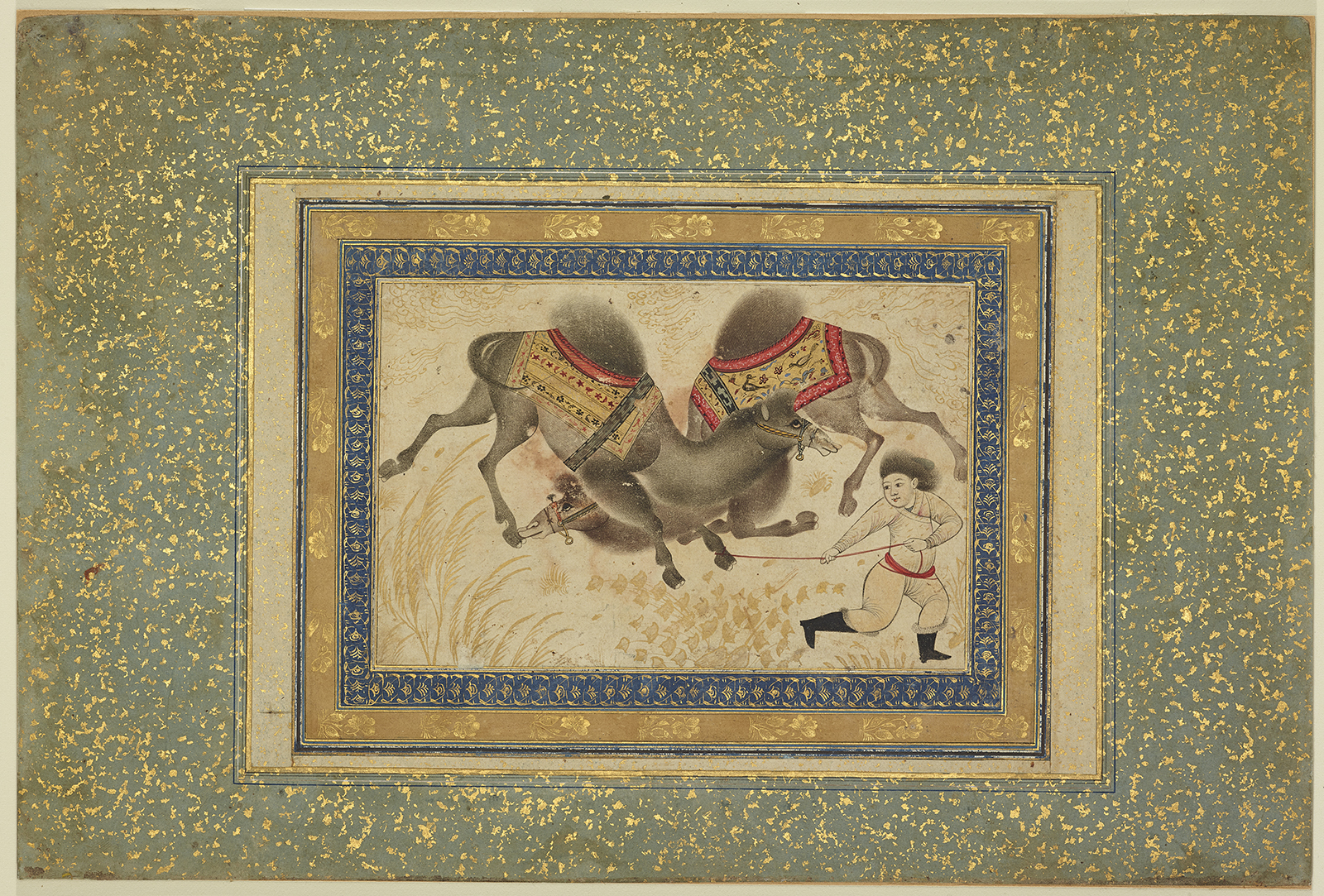Click on the image to zoom
Two Fighting Camels
- Accession Number:AKM75
- Place:Iran, Isfahan
- Dimensions:25.1 × 37.1 cm
- Date:ca. 1630
- Materials and Technique:Ink and opaque watercolour on paper
A camel fight—whether between a pair of Bactrian (two-humped) camels or between Arabian (one-humped) dromedaries—became a common artistic theme in both Iran and Mughal India (1526–1857) in the 16th and 17th centuries. Though artists depicted either male or female camels, the fighting instinct is, in nature, generally limited to the herd-dominating male, and most often expressed during rutting season.[1] For artists, the theme offered an attractive artistic challenge: how to execute two mirror images in a powerful way. A masterful prototype of this theme also existed in a work attributed to the great Timurid artist Bihzad (ca. 1450–ca. 1535). Originally held in the library of Mughal emperors Akbar and his son Jahangir before being moved to the Golestan Palace Library’s Golshan Album in Tehran, Bizhad’s drawing would have been accessible to artists, especially those who worked in the courtly workshops.[2]
Further Reading
Bihzad’s exceptional depiction of fighting camels—which inspired generations of artists in Iran and Mughal India to reach a new level of artistic excellence—bears an inscription with his name and an acknowledgement that, at the time of its creation, the artist was 70 years old and wealthy in experience. It portrays three men, one spinning camel hair in the background, the second beating a camel with a stick, and the third dragging at the second camel’s rope.[3] Only the last figure remains in Two Fighting Camels at the Aga Khan Museum. However, like Bihzad’s work, the Aga Khan Museum example does not demonstrate the violence of the fight. It is a peaceful scene, with the rope holder almost smiling and the camels appearing somewhat bored.
Framed by illuminated borders and mounted on light blue, gold-flecked paper, this single-page drawing seems to have been executed for an album. The landscape (suggested by willow branches and triangular leaves) and sky (suggested by wispy clouds) are typical of Isfahan artists of the 17th century,[4] while the naturalistic style of the camels’ eyes recalls animals depicted by the artists of Mughal India.
— Filiz Çakır Phillip
Notes
[1] See Adel Adamova and J.M. Rogers, “The Iconography of ‘A Camel Fight.’” Muqarnas 21 (2004): 6.
[2] See Adel Adamova and J.M. Rogers for a discussion of where and how the Bihzad prototype has been stored. Adamova and Rogers also detail the inscription on this work.
[3] In an unpublished article, Moya Carey notes that the existence of prototype attributed to Bihzad provided great motivation to artists to reproduce it. For a discussion of how the Bihzad painting has been widely accepted as the prototype of a series of such depictions throughout the 16th and 17th centuries in Iran and Mughal India, see Eric Schroeder, 3; Richard Ettinghausen, “Bihzad,” Encyclopedia of Islam, vol. 1, 2nd edition; Welch, Collection of Islamic Art, vol. 1, 184; Swietochowski and Babaie, Persian Drawings in the Metropolitan Museum of Art (New York: Metropolitan Museum of Art, 1989), 46; Roxburgh, “Kamal al-Din Bihzad and Authorship in Persianate Painting,” Muqarnas 17 (2000): 136; and Adamova and Rogers, 2.
[4] See Anthony Welch, 184 for a discussion of the features of 17th-century art produced in Isfahan.
References
Adamova, Adel, and J.M. Rogers. “The Iconography of ‘A Camel Fight.’” Muqarnas 21 (2004): 1–14. ISBN: 9789004139640
Carey, Moya. “Prince and Princess Sadruddin Aga Khan Collection of Islamic Art.” Unpublished manuscript, London, 2002.
Ettinghausen, Richard. “Bihzad,” Encyclopedia of Islam, vol. 1, 2nd edition. Leiden: Brill, 1986. ISBN: 9789004081147
Phillip, Filiz Çakır. Enchanted lines: drawings from the Aga Khan Museum collection. 2014. ISBN: 9780991992874
Roxburgh, David J. “Kamal al-Din Bihzad and Authorship in Persianate Painting,” Muqarnas 17 (2000): 119–146. ISBN: 9789004116696
Schroeder, Eric. “The Persian Exhibition and the Bihzad Problem,” Bulletin of the Fogg Art Museum 7,no.1 (1937): 3–14. https://www.jstor.org/stable/i403559
Swietochowski, Marie Lukens and Susan Babaie. Persian Drawings in the Metropolitan Museum of Art. New York: Metropolitan Museum of Art, 1989. ISBN: 9780870995644
Welch, Anthony. Collection of Islamic Art: Prince Sadruddin Aga Khan, vols. 1 and 3. Geneva: Château de Bellerive, 1972–78.
Note: This online resource is reviewed and updated on an ongoing basis. We are committed to improving this information and will revise and update knowledge about this object as it becomes available.


